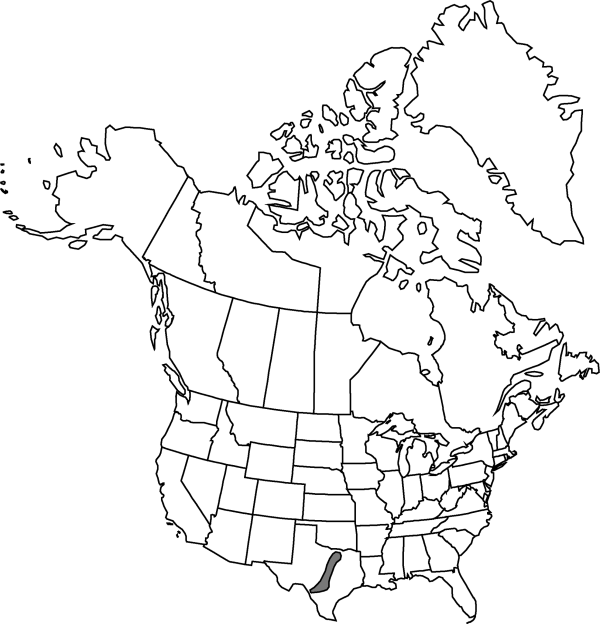Difference between revisions of "Mirabilis latifolia"
Ill. Fl. N. Central Texas, 840. 1999.
FNA>Volume Importer |
imported>Volume Importer |
||
| (6 intermediate revisions by 2 users not shown) | |||
| Line 7: | Line 7: | ||
|year=1999 | |year=1999 | ||
}} | }} | ||
| − | |basionyms={{Treatment/ID/ | + | |special_status={{Treatment/ID/Special_status |
| + | |code=E | ||
| + | |label=Endemic | ||
| + | }} | ||
| + | |basionyms={{Treatment/ID/Basionym | ||
|name=Oxybaphus nyctagineus var. latifolius | |name=Oxybaphus nyctagineus var. latifolius | ||
|authority=A. Gray | |authority=A. Gray | ||
| + | |rank=variety | ||
| + | |publication_title=in W. H. Emory, Rep. U.S. Mex. Bound. | ||
| + | |publication_place=2(1): 174. 1859 | ||
}} | }} | ||
|synonyms={{Treatment/ID/Synonym | |synonyms={{Treatment/ID/Synonym | ||
|name=Allionia latifolia | |name=Allionia latifolia | ||
|authority=(A. Gray) Standley | |authority=(A. Gray) Standley | ||
| + | |rank=species | ||
}} | }} | ||
|hierarchy=Nyctaginaceae;Mirabilis;Mirabilis sect. Oxybaphus;Mirabilis latifolia | |hierarchy=Nyctaginaceae;Mirabilis;Mirabilis sect. Oxybaphus;Mirabilis latifolia | ||
| Line 29: | Line 37: | ||
|elevation=300-600 m | |elevation=300-600 m | ||
|distribution=Tex. | |distribution=Tex. | ||
| − | |discussion=<p>Mirabilis latifolia resembles a small-leaved M. nyctaginea with brown or dark brown fruits, and it may represent populations introgressed by M. albida. In M. dumetorum fruits are said to be 4-ribbed, or often 4-ribbed, apparently an error based on the misinterpretation of misleading, well-pressed, not quite mature, fruits in the type collection.</p> | + | |discussion=<p><i>Mirabilis latifolia</i> resembles a small-leaved <i>M. nyctaginea</i> with brown or dark brown fruits, and it may represent populations introgressed by <i>M. albida</i>. In M. dumetorum fruits are said to be 4-ribbed, or often 4-ribbed, apparently an error based on the misinterpretation of misleading, well-pressed, not quite mature, fruits in the type collection.</p> |
|tables= | |tables= | ||
|references= | |references= | ||
| Line 38: | Line 46: | ||
-->{{#Taxon: | -->{{#Taxon: | ||
name=Mirabilis latifolia | name=Mirabilis latifolia | ||
| − | |||
|authority=(A. Gray) Diggs | |authority=(A. Gray) Diggs | ||
|rank=species | |rank=species | ||
| Line 52: | Line 59: | ||
|publication title=Ill. Fl. N. Central Texas, | |publication title=Ill. Fl. N. Central Texas, | ||
|publication year=1999 | |publication year=1999 | ||
| − | |special status= | + | |special status=Endemic |
| − | |source xml=https:// | + | |source xml=https://bitbucket.org/aafc-mbb/fna-data-curation/src/2e0870ddd59836b60bcf96646a41e87ea5a5943a/coarse_grained_fna_xml/V4/V4_107.xml |
|genus=Mirabilis | |genus=Mirabilis | ||
|section=Mirabilis sect. Oxybaphus | |section=Mirabilis sect. Oxybaphus | ||
Latest revision as of 21:56, 5 November 2020
Stems erect to decumbent, sparsely leafy, leaves distributed throughout, well branched, often sprawling on other plants, 2–11.5 dm, basally usually with 2 lines of minute curved hairs, occasionally glabrous, distally with 2 lines of curved hairs, or evenly puberulent with curved hairs, sometimes also spreading-villous or viscid-villous. Leaves ascending to spreading at 45–90°, abruptly reduced in inflorescence; petiole 0.5–1.2 cm; blade green, lanceolate-triangular to ovate-triangular, 2–5 × 1–4.5 cm, thin or slightly thickened and fleshy, base obtuse to round, rarely attenuate, apex acute, sometimes narrowly so, rarely round, surfaces glabrous. Inflorescences usually terminal, sometimes also with short branches in distal axils, occasionally with single involucres in axils, when terminal, usually with main axis and shorter branches and involucres densely clustered at ends of branches; peduncle 2–7 mm, spreading-villous, usually with short hairs, sometimes viscid, crosswalls of hairs pale or dark; involucres pale green, sometimes tinged with red, widely bell-shaped, 4–6 mm in flower, 8–12 mm in fruit, glabrate and puberulent on margins to spreading-villous, sometimes viscid, 50–75% connate, lobes triangular-ovate to round-ovate. Flowers (2–)3 per involucre; perianth pink to reddish purple, rarely white, 1 cm. Fruits reddish brown, brown, or blackish (ribs and warts usually paler), obovoid, 3.5–5.2 mm, pubescent with tufted hairs from tubercles, sometimes pubescent throughout, hairs 0.1–0.3 mm; ribs round-angular, 0.5–1 times width of sulci, 0.5–1 times as wide as high, rugose, smooth near base and dissected at apex into tall warts, or dissected throughout; sulci with prominent round or shelflike, narrow tubercles.
Phenology: Flowering summer–early fall.
Habitat: Disturbed sites in rocky limestone soils or blackland clay, thickets
Elevation: 300-600 m
Discussion
Mirabilis latifolia resembles a small-leaved M. nyctaginea with brown or dark brown fruits, and it may represent populations introgressed by M. albida. In M. dumetorum fruits are said to be 4-ribbed, or often 4-ribbed, apparently an error based on the misinterpretation of misleading, well-pressed, not quite mature, fruits in the type collection.
Selected References
None.
